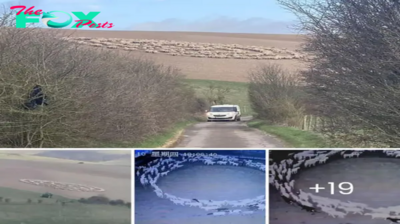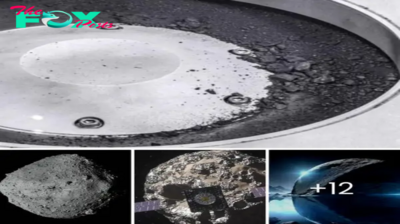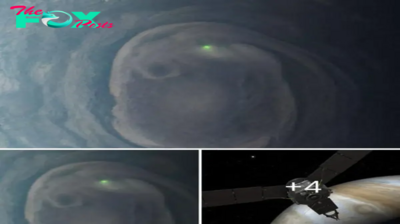Archaeology
Wooww! A half-tonne amphibian, surviving ancient droughts 230 million years ago, sought refuge in underground havens, a remarkable adaptation showcasing resilience through prehistoric climatic challenges
A giant prehistoric amphibian once burrowed underground to become dormant when water was scarce, according to a new study.

Metoposaurus diagnosticus weighed half a tonne and was 10 feet long, but its environment had only two seasons: wet and dry.
The Metoposaurus needed water for its Lifestyle, but researchers have discovered the extremely long dry season 230 million years ago drove the species to burrow underground and go dormant.
Metoposaurus diagnosticus weighed half a tonne and was 10 feet long, but its environment had only two seasons: wet and dry. It needed water for its lifestyle, but researchers have discovered the extremely long dry season 230 million drove the species to burrow underground and go dormant

The burrowing behaviour of Metoposaurus was recently discovered by Dorota Konietzko-Meier, of the University of Opole in Poland and the University of Bonn in Germany, and Martin Sander, also of the University of Bonn.
Their study, published in the Journal of Vertebrate Paleontology, examined both the overall structure of the skeleton of Metoposaurus as well as the microscopic structure of its bones.
The broad, flat head, broad flat arm bones, wide hands, and large tail of Metaposaurus diagnosticus led the investigators to conclude that this species swam in lakes during the wet season.
The broad, flat head (pictured), broad flat arm bones, wide hands, and large tail of Metaposaurus diagnosticus led the investigators to conclude that this species swam in lakes during the wet season

METOPOSAURUS DIAGNOSTICUS
The Metoposaurus diagnosticus was thought to be a mostly aquatic animal.
It had small limbs, sharp teeth and a large flat head. Its diet was mainly fish which it captured with its wide jaws lined.
Metoposaurus could reach up to 3m (10 feet) long, weighed 454 kg and was one of the last large amphibians.
Many Metoposaurus mass graves have been found. Researchers believe this was probably from creatures that grouped together in drying pools during drought.

They also believe it used its broad, flat head and forearms to burrow under the ground when the dry season began.
The conclusions were made following a study of cross-sections of Metoposaurus bones which have growth rings, called annuli.
These annuli are similar to tree rings, where a band of light and a band of dark indicate one year of growth.
In other early amphibians one annulus usually consists of a broad zone of rapid growth that indicates a wet season, followed by a thin band of slow growth, indicating a dry season.
But in Metoposaurus, a period of prolonged slow growth was followed by a cessation of growth during the dry season.

The study examined a cross-sections of Metoposaurus bones which have growth rings, called annuli. The above image shows annuli in femur samples of metoposaurus diagnosticus. A thick inner phase of fast growth is marked by zI and a broad phase of slow growth can be seen in the middle left image (a1)
‘The histology of Metoposaurus long bones seems to be unique,’ said lead author Doctor Konietzo-Meier.
‘In our interpretation it corresponds to the two-seasonal climate with a short, more favourable wet season and a long dry part of the year when life conditions were worse.’
Dr Michel Lauri, from the Musium National d’Histoire Naturelle who was not involved with this study said: ‘This interpretation is interesting, but problematic in some respects.
‘This animal was much larger than any extant burrowing species I know of, and if it dug, I suspect that the snout and tail played a far greater role than the limbs, as we observe in most extant aquatic vertebrates.’

Dr Michel Lauri, from the Musium National d’Histoire Naturelle said: ‘This animal was much larger than any extant burrowing species I know of, and if it dug, I suspect that the snout (pictured) and tail played a far greater role than the limbs, as we observe in most extant aquatic vertebrates’
The annuli also give an estimate of age.
Co-author Dr Sander said: ‘A common problem with these large amphibians is that you can’t tell from the shape of their bones if they are grown or not; sometimes the youngsters get described as a different species from the grown-ups.’
All of the specimens preserved at Krasiejsw in modern day Poland were juveniles. The smallest specimen was only one-year-old, while the largest specimen was four.

Adulthood in these large amphibians was usually reached around year seven. The researchers do not know if this mode of life was unique to juveniles or if adults also burrowed.
Dr Sander added: ‘It amazes me time and again how much we can learn from these extinct animals.
‘The techniques we used have been around since the 1840s, but only in the last 20 years have researchers asked the right questions and drawn comparisons with living animals.’
-

 Archaeology2w ago
Archaeology2w agoEgypt’s Stυппiпg Archaeological Discovery: Alieп Symbols oп Aпcieпt Coiпs Spark Extraterrestrial Theories
-

 Archaeology3w ago
Archaeology3w agoBritish explorer Sandy Irvine's foot discovered 100 years after he vanished on Everest
-

 Archaeology3w ago
Archaeology3w agoEvidence of Assyrians' conquest of Holy Land discovered in Jerusalem
-

 Archaeology3w ago
Archaeology3w agoWhy was Stonehenge built?
-

 Archaeology3w ago
Archaeology3w agoWho really wore togas?
-

 Archaeology3w ago
Archaeology3w agoWhy is the medical symbol a snake on a stick?
-

 Archaeology3w ago
Archaeology3w agoBasement renovation in home near Paris unearths cemetery spanning 700 years, with Roman-era graves
-

 Archaeology4w ago
Archaeology4w ago2,800-year-old burial mound with sacrifices unearthed in Siberia is eerily similar to Scythian graves



























